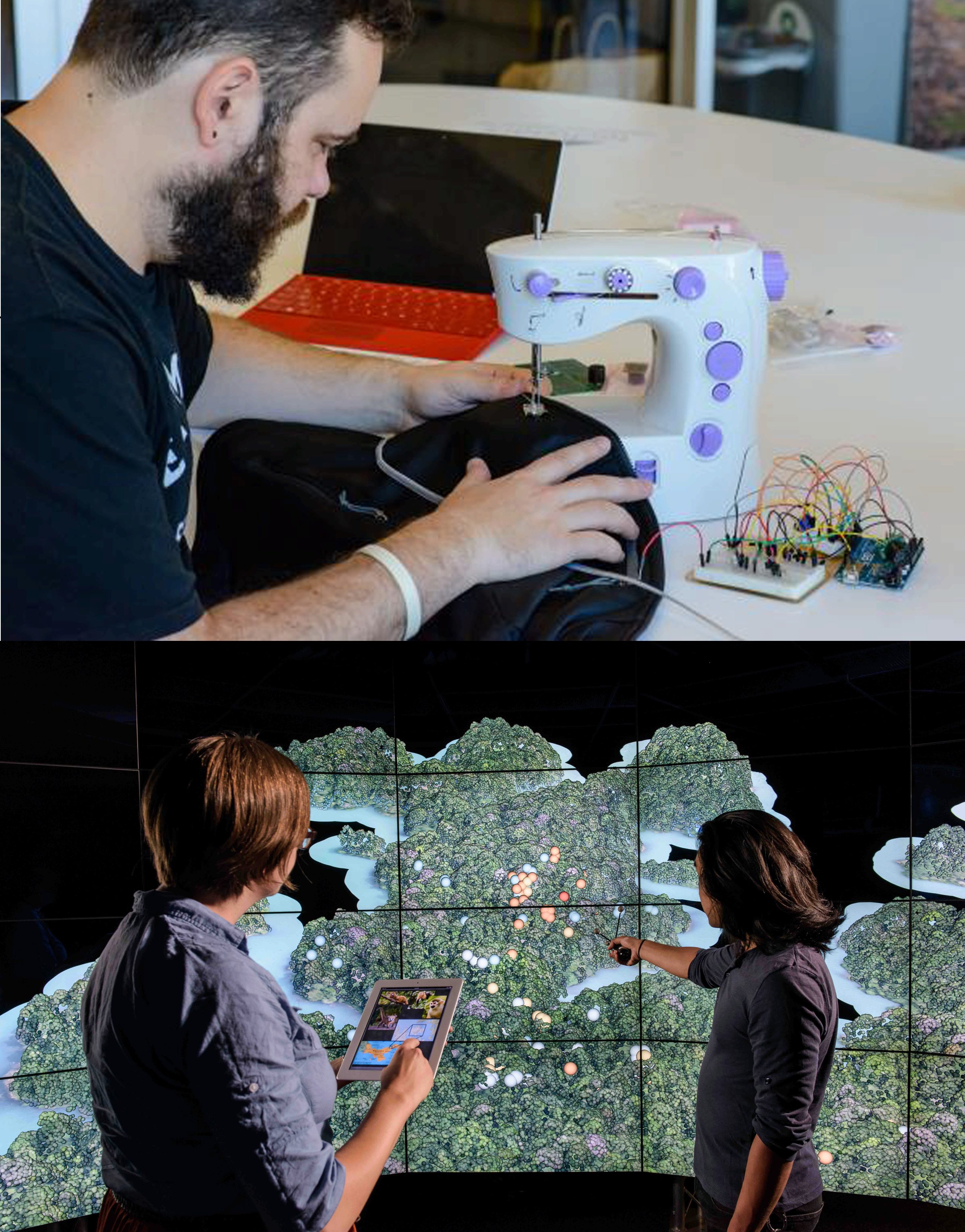UIC/EVL Students Recognized in 2016 UIC Image of Research Competition
September 7th, 2016
Categories: Applications, Software, Visualization, VR, Human Augmentics

About
This year, UIC Computer Science (CS) PhD student and Electronic Visualization Laboratory (EVL) research assistant Victor Mateevitsi received 1st Place for his “SpiderSense” image in the campus’s 2016 Image of Research competition. In addition, an Honorable Mention was earned by CS PhD student and EVL research assistant Jillian Aurisano and CS undergraduate and EVL Research Experiences for Undergraduates (REU) student James Hwang for their “Into the (Virtual) Jungle” image.
“SpiderSense” explores how technologies can augment and enhance humans and human interactions, an area of research termed Human Augmentics. The winning image shows Victor assembling SpiderSense, a wearable haptic jacket that allows wearers to feel the environment on their own body. The jacket consists of 12 sensors that scan the environment using echolocation; as the wearer approaches an obstacle, the intensity of the haptic vibration increases and/or decreases as he gets closer or further away. Victor, who is completing his PhD with CS associate professor Andrew Johnson, had to learn to sew, combining textiles with electronics, and to study how to communicate messages through the skin. This technology can be life changing for the blind, as they could now “see” through their own skin. Future applications include firefighters, policemen and soldiers.
“Into the (Virtual) Jungle” transforms maps, aerial photography, LIDAR data and elevation data of Barro Colorado Island, a research habitat in Panama, into a virtual world, on which it superimposes tracked animal movements, enabling anthropologist Meg Crofoot (UCDavis) and computer scientist Tanya Berger-Wolf (UIC CS) to explore how virtual reality might help animal behavior researchers view, explore and step inside their data. This technology will enable collaborators to stand on the ground, leap through the trees or fly above the canopy to observe how tracked animals forage for food. This winning image shows the GPS locations of one capuchin monkey, visualized as spheres colored on a blue-orange gradient by time of day, to show how often he visits pink-hued fruit trees in the canopy. REU support for Hwang is provided by the NSF Award SENSEI (Sensor Environment Imaging Instrument), EVL director Maxine Brown, principal investigator.
Winning entries will be displayed in the lobby of the Daley Library from October 11 through January 31. The winning entries will also be on exhibit at the Library of Health Sciences and on banners around campus. For information on the 2016 awards as well as a list of all exhibition winners and finalists from the competition’s inception, see:
http://grad.uic.edu/image-research-exhibit
http://grad.uic.edu/ior-results/2016 (2016 Winners and Finalists)
It should be noted that Image of Research judges used EVL’s largest tiled display system, the CAVE2 hybrid reality environment, to display all the submissions at once in high resolution for easy comparison and grouping.
# # #
EVL students have participated in and received recognition in previous Image of Research competitions. Here is a summary of all EVL accomplishments to date:
2014: Honorable Mention - “Getting in Touch with the Data,” Arthur Nishimoto
2013: 1st Place - “Threshold,” Joshua Albers; 2nd place - “A Nanoscale Forest Seen Through a Big Lens,” Khairi Reda; Finalist - “SpiderSense,” Victor Mateevitsi, Brad Haggadone, Brian Kunzer
2012: 1st Place - “Artificially created cortical functional blood unit,” Thomas Marrinan, Ian Gould
2011: Honorable Mention - “20 Foot Canvas,” JD Pirtle, Arthur Nishimoto, Karan Chakrapani, Todd Silvia, and Philip Pilosi; Finalist - “Cli-Mate,” Ed Kahler
2010: 1st Place - “Avatar - A Virtual Human,” Sangyoon Lee
2009: Honorable Mention - “The Viewer,” Julio Obelleiro; Finalist - “The Tight Room,” Heejoo Kim
2008: 1st Place - “Infinity Gliders,” AnnMarie Cernoch; 3rd Place - “Rain on Mars,” Dmitri Svistula
# # #